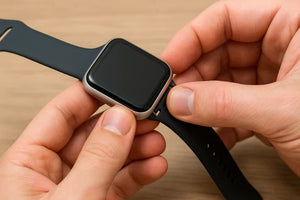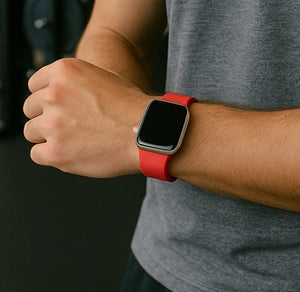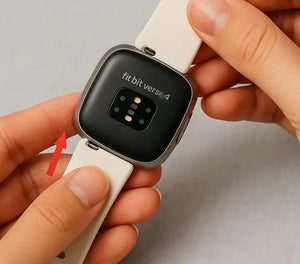
Are you curious about how fast you might run your next race? Garmin’s Race Predictor might be your new best friend when it comes to tracking your running metrics. This handy feature on select Garmin watches estimates your race times based on your training. It's like having a coach on your wrist, helping you set yourself realistic goals to train towards. In this post, we will break down how it works, which watches have it, and how accurate it really is. Plus, we’ll touch on some drawbacks you might want to consider. Stick around to see how this tool can help you gear up for your next race day.
👉 Serious about your training? 🎯 Get the most accurate race predictions by ensuring your Garmin stays secure with a [high-performance Garmin watch strap]
Can My Garmin Predict My Race Time?
Yes, your Garmin can predict your race time! If you’ve been training hard and want to get an idea of how you might perform on race day, Garmin’s Race Predictor feature is here to help you out. It uses your training history and VO2 max to provide an estimate of your race time for different distances.
This means if you’re gearing up for the London Marathon next year or a local half marathon in a few month's time, your watch can give you an idea of what to expect. It pulls in data from your recent runs and uses it to generate race predictions. The more you run, the more accurate your predictions will be.
However, remember that factors like race day conditions and how you feel on the big day can affect your performance. If you’re training consistently but feeling like your times are worse than predicted, don’t worry. A lot can change in the weeks leading up to your race. Keep at it, and trust your training process!

What Garmin Watches Have Race Predictor?
Not all Garmin watches come with the Race Predictor feature, but plenty of models now do. If you’re looking for a watch that helps predict your race times, you’re in luck. Here’s a list of some of the top options:
- Garmin Forerunner 55
- Garmin Forerunner 165 | 165 Music
- Garmin Forerunner 255 | 255S | 255 Music | 255S Music
- Garmin Forerunner 265 | 265S
- Garmin Forerunner 955 | 955 Solar
- Garmin Fenix 7 Pro | 7S Pro | 7X Pro - Solar & Sapphire Editions
- Garmin Fenix 8 - AMOLED & Solar Editions
- Garmin Fenix E
- Garmin Epix (Gen 2) | Epix (Gen 2) Sapphire | Epix (Gen 2) Porsche Edition
- Garmin Epix Pro (Gen 2) - Standard & Sapphire Editions
- Garmin Enduro 2 | Enduro 3
- Garmin Quatix 6 | 6X Solar | 6 Titanium
- Garmin Quatix 7 Series
- Garmin Tactix 7 Series | Tactix Delta Series
- Garmin Instinct 2 Series (Various Editions)
- Garmin MARQ Adventurer | Athlete | Aviator | Captain | Golfer | Commander | Driver | Expedition (Gen 1 & 2)
- Garmin D2 Mach 1 | Mach 1 Pro
- Garmin Descent Mk3
These smartwatches for runners are built for athletes who want more than just basic fitness tracking. Whether you’re training for a 5K or a marathon, Race Predictor can help you gauge where you stand. It’s beneficial if you’ve been consistently running and want to see how your training could translate to your race day performance.
You don’t need the latest model to enjoy this feature either. Many of the older Forerunner and Fenix series still support it, making it accessible for runners at all levels. Just make sure your watch is always updated to get the best results.
How Does Garmin Race Predictor Work?
Curious about how your Garmin Race Predictor crunches the numbers? It’s pretty cool, to be honest. Here’s how it works: your running watch collects tons of data during your workouts, including your pace, heart rate, and overall effort. This data is synced with Garmin Connect, and that's where the real magic happens.
Garmin Connect analyses your performance and combines it with your VO2 max—a measure of your aerobic fitness. It uses this information to predict how you might do in races of different distances, like a 5K, 10K, or marathon. By looking at your recent runs and training history, it generates a race prediction that gives you a rough idea of your potential race time.
The system also considers your current fitness level and any changes over time, so you get an estimate based on your most recent efforts. It’s a great way to gauge how your running training is going and adjust your goals. Just remember, these predictions are guides, not full-on guarantees. Your actual race time can vary based on many factors, but Garmin’s tools give you a solid starting point to work with.
👉 Keen on tracking your progress? 💪 Make sure your Garmin stays put during intense sessions with a [durable sports strap] from Fitstraps.

Benefits of Fitstraps
Enhance your Garmin experience with a fresh new band for your Garmin from Fitstraps. Whether you’re running a marathon or heading to a formal event, our extensive selection of Garmin watch straps has you covered.
From colourful and breathable sports bands perfect for intense workouts to sleek leather straps for a touch of sophistication, we offer options to match every occasion. A new strap can not only refresh the look of your running watch but also improve comfort during those long training sessions.
Plus, all our straps are designed to securely fit your Garmin, ensuring your device stays protected. By choosing Fitstraps, you’re investing in quality and style, making your Garmin even more versatile for all your activities. So why settle for a single look when you can switch it up to suit your mood and outfit?
How Accurate Is Garmin Race Predictor?
Garmin’s Race Predictor is a handy tool, but its accuracy can vary. As we touched on above, it provides a forecast based on your recent runs and training history, using your VO2 max and other performance data to estimate your potential race time. If you’ve been consistent with your training and your data is up-to-date, the predictions can be pretty close to what you might expect on race day.
However, remember, as we said above, these are just predictions. Factors like weather, race day conditions, and your overall health can influence your performance and obviously cannot be predicted by your device. The estimate might be a bit off if you’re dealing with unexpected issues or if you haven’t been able to maintain your training.
In essence, Garmin’s Race Predictor gives you a solid guideline, but it’s not a mystic Meg's crystal ball. It’s best used as a motivator and a way to set realistic goals rather than a guaranteed outcome. Keep your expectations in check, and use the predictions to guide your training rather than define it.
👉 Want to improve your fitness data tracking accuracy? 🚀 A comfortable and snug watch strap fit is absolutely key. [Upgrade your performance Garmin strap] for ultimate comfort and precision.
What Are the Main Drawbacks of Using Garmin Race Predictor?
While Garmin’s Race Predictor is a cool feature, like everything, it does have its limitations. One major drawback is that it relies heavily on your training history and VO2 max, which means if your data isn’t current or accurate, your predictions can be way off. For instance, if you’ve had a few bad weeks or missed some key workouts, due to injury, the estimates might not reflect your true potential.
Another issue as we touched on above is that the predictions don’t account for race-day variables. Factors like weather, course terrain, your nutrition, stress levels and even your general mood can affect your performance, making the forecast less reliable. Plus, if you’re new to running or haven’t been consistent with your training, the tool might not provide accurate predictions, as it doesn’t account for sudden improvements or setbacks.
In short, while Garmin’s Race Predictor can be a useful guide, it’s not foolproof. Use it as one tool among many to plan your training and set your goals, but don’t rely on it to make or break your race experience.
👉 Maximise your race-day potential with a secure, sweat-proof watch strap. 🏃♂️ [See our range of peak-performance straps for Garmin] built specifically for those looking for peak performance.
Conclusion
Garmin’s Race Predictor is a fantastic tool for setting race goals and tracking your progress, but it’s important to remember it’s not a perfect science. It uses your training history and VO2 max score to give you a rough estimate of your race times, which can be incredibly useful for planning and motivation. However, be aware that these predictions are based on the data you provide and don’t account for all the variables on race day.
While the feature can help you gauge where you stand and how to adjust your training, it’s best used as a guideline rather than a guarantee. Keep in mind the drawbacks, such as the potential for outdated data or unexpected race-day conditions. Ultimately, trust your training, stay flexible, and use the Race Predictor to support your running goals. With the right mindset, it’s a great tool to help you aim high and push your limits.
 How To Fix an Apple Watch Strap
How To Fix an Apple Watch Strap
 Cool Fitbit Versa 2 Bands: Style, Comfort, and Performance Combined
Cool Fitbit Versa 2 Bands: Style, Comfort, and Performance Combined
 Mens Leather Apple Watch Strap Styles Built for Everyday Sophistication
Mens Leather Apple Watch Strap Styles Built for Everyday Sophistication
 Apple Watch Strap Broken? Don’t Panic — Read This First
Apple Watch Strap Broken? Don’t Panic — Read This First
 How to Change Strap on Fitbit Versa 4: A Complete Step-by-Step Guide
How to Change Strap on Fitbit Versa 4: A Complete Step-by-Step Guide
 The Best Metal Bands for Apple Watch
The Best Metal Bands for Apple Watch
 How to Change Garmin Watch Strap: Complete Step-by-Step Guide
How to Change Garmin Watch Strap: Complete Step-by-Step Guide
 XL Apple Watch Band - Designed for Bigger Wrists, Built for Comfort
XL Apple Watch Band - Designed for Bigger Wrists, Built for Comfort




